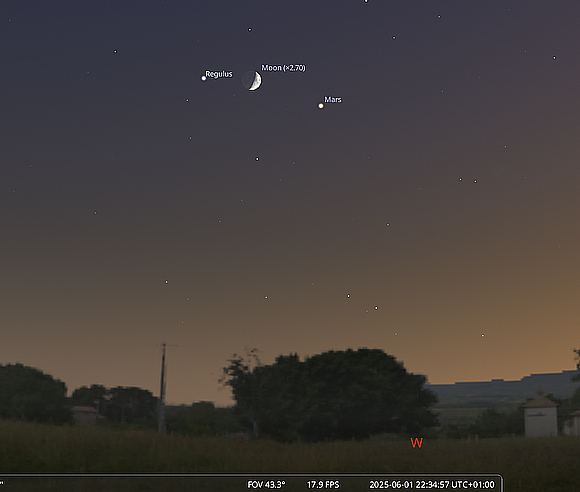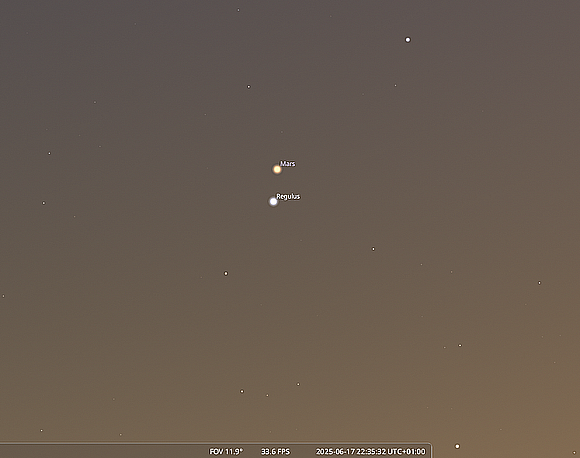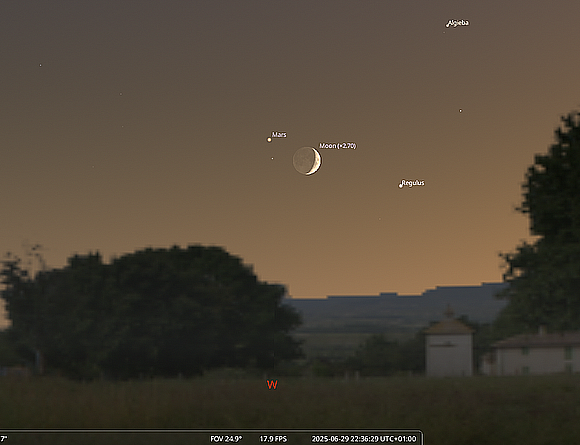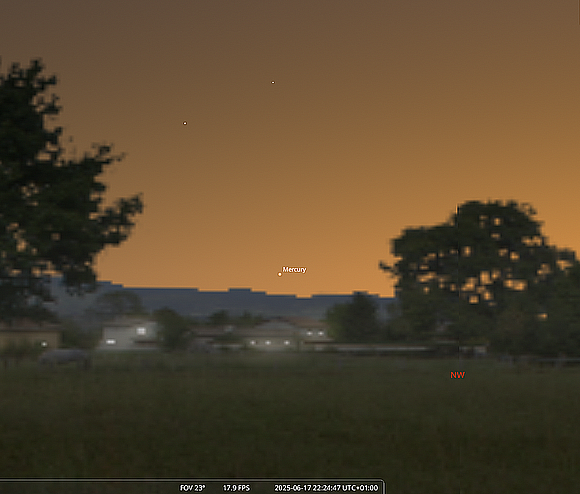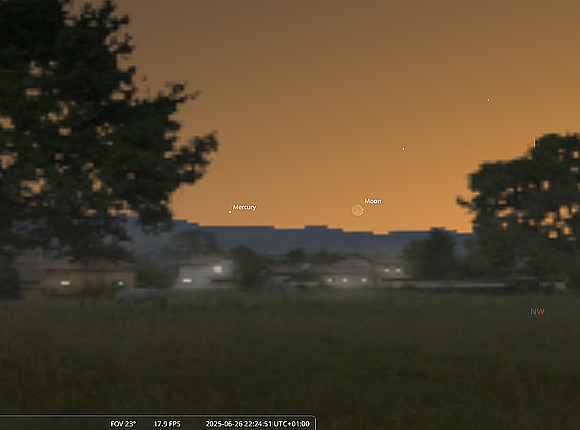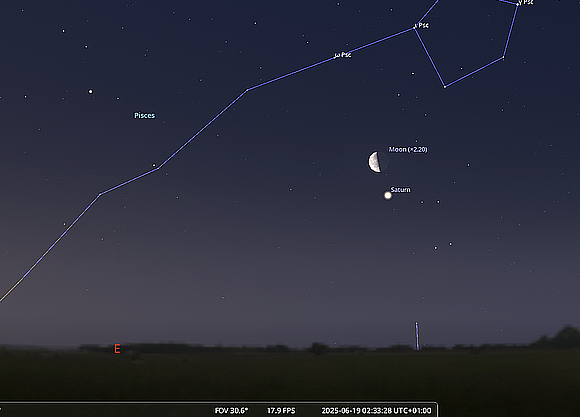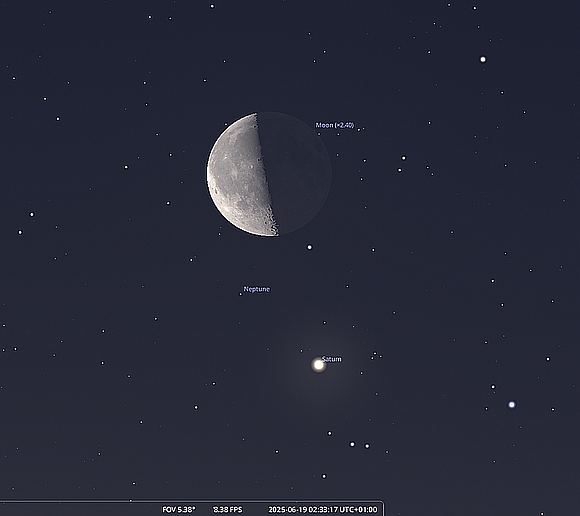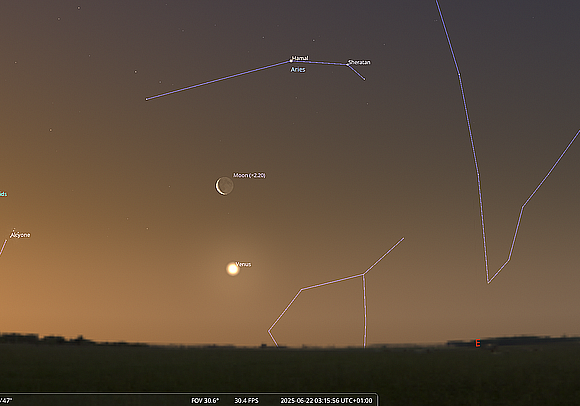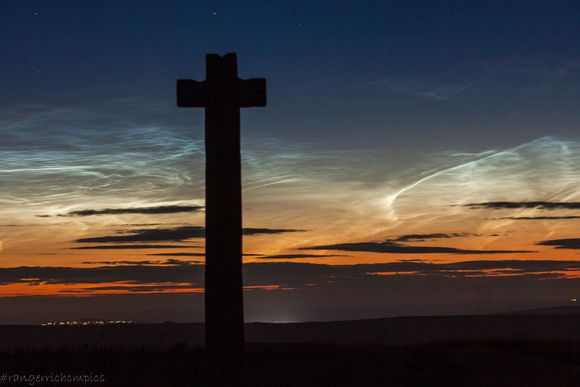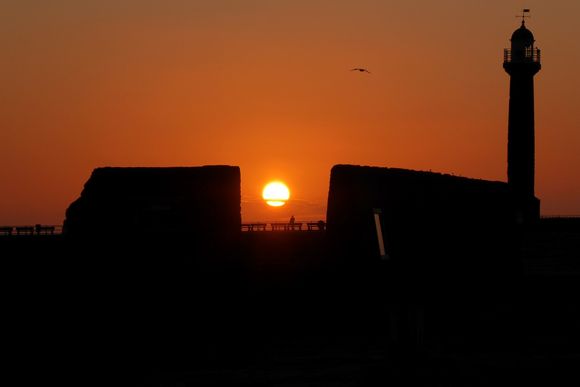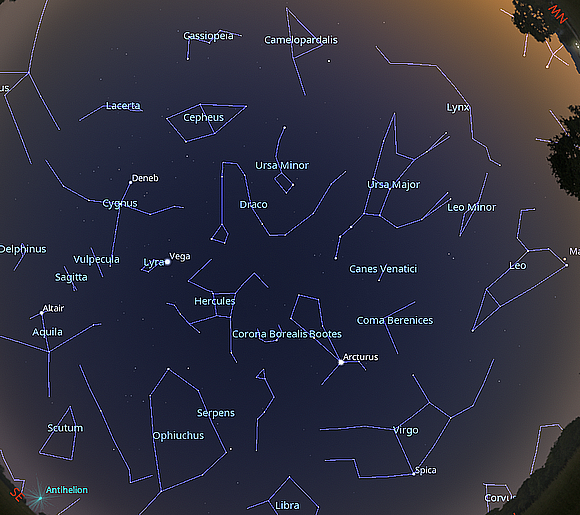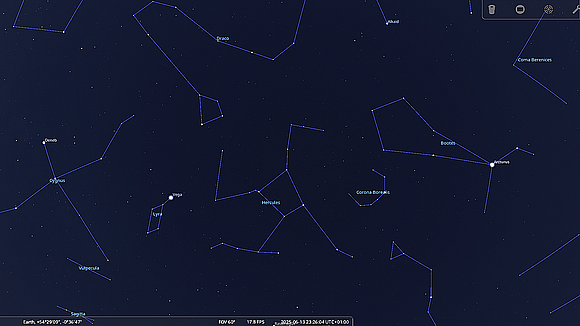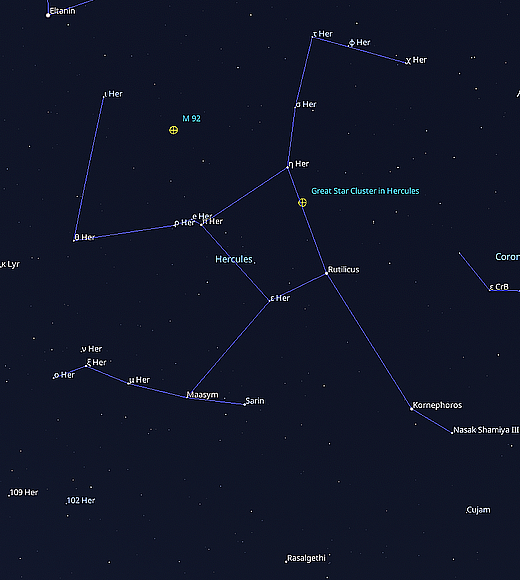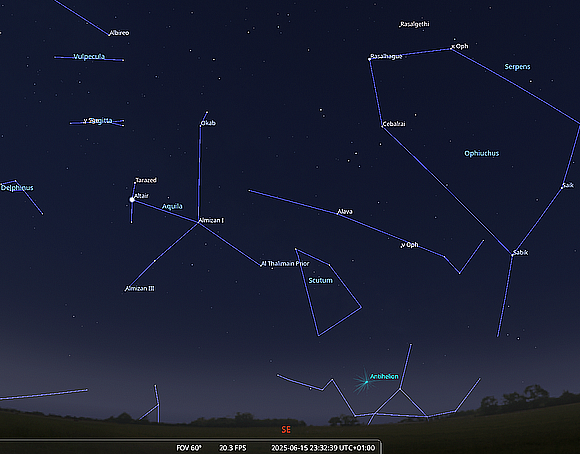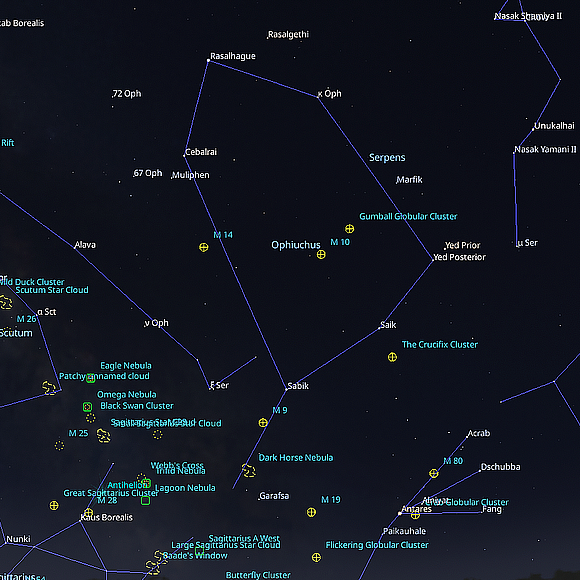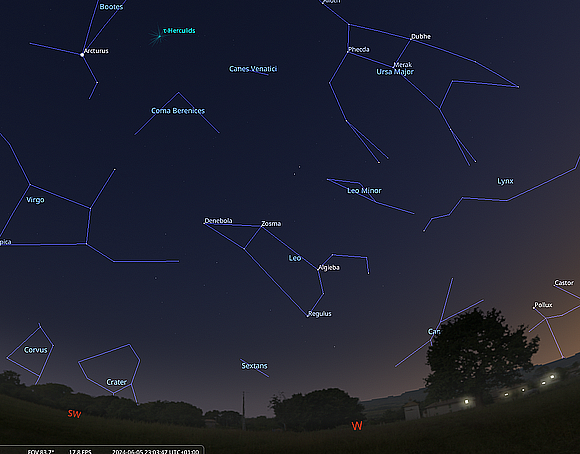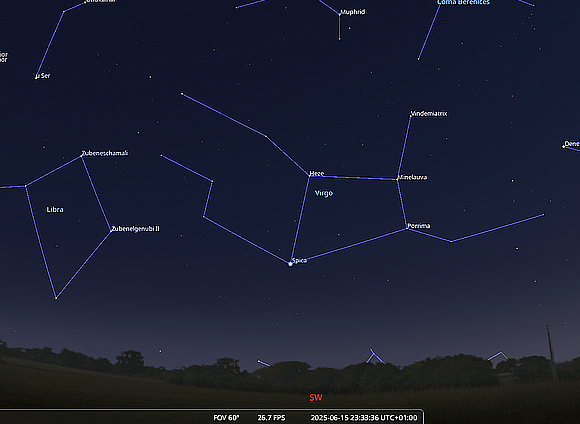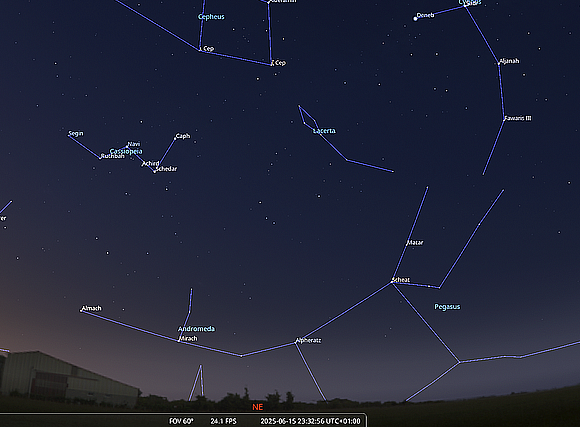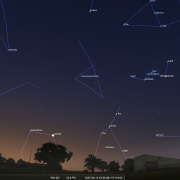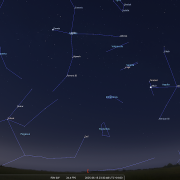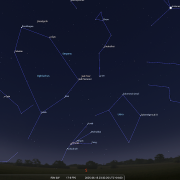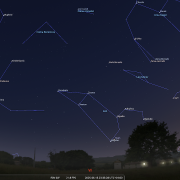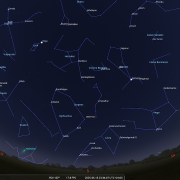In this month's Sky Notes:
- Planetary Skylights.
- June Meteors, Noctilucent cloud.
- Summer Solstice.
- June Night Sky.
- June 2025 Sky Charts.
Planetary Skylights: A Brief Guide to June's Night Sky
Given the long light nights and early dawn, June on the face of it appears a quiet month for planetary action. Mars is the sole evening planet readily visible, whilst Mercury commences a poor evening apparition mid-month. Venus and Saturn are to be found in the dawn sky.
 Mars spends the month in the constellation Leo gradually moving towards its principal star, Regulus. Although Mars will still be readily visible to the naked eye, it will dim to magnitude +1.5 by the end of the month, slightly less bright than Regulus. Observers will have the opportunity to compare the two during mid-June, with Mars passing just above Regulus, and the pair being separated by approximately 0.7 degrees on June 17th. It will be of interest to compare the colour contrast between the two when viewed through a telescope. The Moon will be in proximity to Mars twice in June, on the 1st and again on the 29th. Telescopically, Mars will reveal minimal detail, its small disk (just over 5 arc-seconds) now over 273 million km distant. By the end of June, Mars will be visible for a brief period of approximately 35 minutes before setting below the horizon.
Mars spends the month in the constellation Leo gradually moving towards its principal star, Regulus. Although Mars will still be readily visible to the naked eye, it will dim to magnitude +1.5 by the end of the month, slightly less bright than Regulus. Observers will have the opportunity to compare the two during mid-June, with Mars passing just above Regulus, and the pair being separated by approximately 0.7 degrees on June 17th. It will be of interest to compare the colour contrast between the two when viewed through a telescope. The Moon will be in proximity to Mars twice in June, on the 1st and again on the 29th. Telescopically, Mars will reveal minimal detail, its small disk (just over 5 arc-seconds) now over 273 million km distant. By the end of June, Mars will be visible for a brief period of approximately 35 minutes before setting below the horizon.
 Mercury moves east of the Sun following its superior conjunction on the far side, becoming visible in the evening twilight sky. This particular evening apparition is unfavourable for observers in the UK, as Mercury will only reach a maximum elevation of approximately 5.5 degrees above the west-northwest horizon around June 22nd. The planet will become apparent a week before this date observing from 22:15hrs.
Mercury moves east of the Sun following its superior conjunction on the far side, becoming visible in the evening twilight sky. This particular evening apparition is unfavourable for observers in the UK, as Mercury will only reach a maximum elevation of approximately 5.5 degrees above the west-northwest horizon around June 22nd. The planet will become apparent a week before this date observing from 22:15hrs.
During evening apparitions, Mercury is at its brightest at the beginning, with an approximate magnitude of -0.6, gradually fading to +0.36 by the end of June. To observe Mercury, a flat aspect is necessary but if sky conditions are suitable, binoculars should help identify Mercury in the twilight glow scanning above the west-northwest horizon. On June 26th, a very slender crescent Moon will be positioned to the right of Mercury. View at 22:20hrs.
 Saturn continues to move away from the Sun in the early dawn sky and will be visible from UK latitudes low in the ESE by 03:00 BST at the onset of June, and around 01:00 by the end of the month. The window for observation will however be limited to a few hours due to the short nights. Saturn's elevation above the horizon will increase from approximately 4 degrees at 03:00 at the start of June to around 20 degrees at the same time by the month's end.
Saturn continues to move away from the Sun in the early dawn sky and will be visible from UK latitudes low in the ESE by 03:00 BST at the onset of June, and around 01:00 by the end of the month. The window for observation will however be limited to a few hours due to the short nights. Saturn's elevation above the horizon will increase from approximately 4 degrees at 03:00 at the start of June to around 20 degrees at the same time by the month's end.
Observations of Saturn through a telescope gradually improve over the course of the month, though viewing conditions will still be marginal. It is important to note that the inclination of Saturn's ring system is about 2 degrees this year, which is a ring crossing year when the rings appear edge-on, reaching this orientation again in November.
On June 19th, for those who are early risers or stay up late, a waning quarter Moon will be positioned above Saturn with faint Neptune situated between them.
 Having transitioned from the evening sky to the dawn sky, Venus gradually moves away from the eastern horizon as the month progresses. However, it will still only be slightly more than 10 degrees above the horizon at 04:00hrs by the end of June. This morning appearance of Venus is not ideal for mid-northern latitudes, with an observation window barely more than 90 minutes starting at 02:45hrs - making it less accessible for observers. Nevertheless, at magnitude -4.3, Venus remains bright and will be visible through the brightening dawn skies for a short period. Observing Venus through a telescope will reveal its phase, which increases to 62% by the end of the month. On June 19th, a waning crescent Moon will be visible above Venus at 03:00hrs BST.
Having transitioned from the evening sky to the dawn sky, Venus gradually moves away from the eastern horizon as the month progresses. However, it will still only be slightly more than 10 degrees above the horizon at 04:00hrs by the end of June. This morning appearance of Venus is not ideal for mid-northern latitudes, with an observation window barely more than 90 minutes starting at 02:45hrs - making it less accessible for observers. Nevertheless, at magnitude -4.3, Venus remains bright and will be visible through the brightening dawn skies for a short period. Observing Venus through a telescope will reveal its phase, which increases to 62% by the end of the month. On June 19th, a waning crescent Moon will be visible above Venus at 03:00hrs BST.
June Meteors - Noctilucent Cloud Watch
Meteor activity is sparse throughout June with no well-defined meteor showers to speak of. This low level of observed activity is due to several reasons, the short, light nights being one. Also, the ecliptic is low to the south as seen from the UK at this time of year, the chief source of any low meteor activity. Finally, the minor showers that are apparent produce only a handful of meteors at best.
The Ophiuchids, the radiant of which lies near Theta Ophiuchi - approximately 15 degrees east of Antares, may produce 5 or so per hour with peaks on June 9th and 19th. The Beta Taurids are associated with debris left by Comet P/Encke, but unfortunately the shower occurs during daylight hours over the course of June. Radio detection methods do seem to indicate the shower is one of the strongest 'radio meteor showers' of the year.
The Alpha Cygnids yields just a few meteors per hour near the end of June. The radiant lies close to Deneb, which is at least high in the NE sky!
Noctilucent Cloud - June Peak
There have been no sightings of noctilucent cloud so far this year, however June offers up the best chance, with the peak of the noctilucent cloud season normally falling between mid-June to late-July. This rather beautiful type of cloud formation only forms during the summer months above the northern horizon long after sunset, often around midnight. Its appearance is quite distinct, shining quite brightly, exhibiting a characteristic silvery-blue hue and filamentary in structure. It forms exclusively between latitudes 50 and 60 degrees north, at an altitude of over 50 miles, five times higher than normal clouds. The cloud forms when water vapour condenses at the low temperatures that prevail at such altitudes onto particles suspended in the air. Most certainly keep an eye out to the north as twilight deepens.
The Summer Solstice
The summer solstice in the northern hemisphere occurs on June 21st this year, when the Sun reaches its highest point in the sky along the ecliptic—the path it takes across the sky throughout the year. The term "solstice" originates from the Latin word’s sol (meaning "Sun") and sistere (meaning "to come to a stop or stand still"). On the day of the June solstice, the Sun attains its northernmost position as observed from the northern hemisphere of Earth, remaining stationary at the Tropic of Cancer. Subsequently, the Sun reverses direction and begins moving southward. The opposite phenomenon occurs during the December solstice, when the Sun reaches its southernmost position corresponding to the Tropic of Capricorn.
It is a common misconception that Earth is closer to the Sun during this time of year; however, the reality is quite the contrary. Earth is farthest from the Sun on July 4th, at nearly 95 million miles, approximately 3 million miles farther than its closest approach in early January. The warmth experienced during this period is due to the inclination of the northern hemisphere towards the Sun, resulting in a higher concentration of sunlight per unit area. This effect can be likened to a spotlight directed at the palm of one's hand, where direct radiation causes increased warmth, whereas a tilted angle reduces heat intensity. In June, the actual intensity of solar radiation is approximately 1.2KW of heat per square metre on the surface.
The summer solstice is currently located at the border of the Gemini and Taurus constellations. However, this was not always the case. Thousands of years ago, the summer solstice was observed in front of the stars of Cancer in the northern hemisphere, but because of precession—Earth’s gradual axial wobble—it has shifted over time.
At our latitude, we never see the Sun directly overhead. However, within latitudes 23.5 degrees North and 23.5 degrees South, the Sun can appear directly overhead, casting no shadows. This phenomenon was noted by astronomers in antiquity. The term "Tropic of Cancer" originated because, at that time, the summer solstice occurred in front of the stars of the Cancer constellation. Similarly, when the Sun was positioned before the stars of Capricorn at its southernmost limit on the ecliptic (during the winter solstice), 23.5 degrees south of the celestial equator, it led to the naming of the "Tropic of Capricorn."
Astronomers denote the June solstice as the commencement of summer in the Northern Hemisphere, while meteorologists recognize the season's beginning almost three weeks earlier, on June 1. Despite being labelled the longest day, the earliest sunrise and latest sunset do not coincide with the date of the summer solstice. In Whitby, for example, the earliest sunrise occurs around June 16 at 04:25 hrs, and the latest sunset takes place on June 25 at 21:42 hrs. The duration of usable daylight reaches its peak on June 21, totalling just over 17 hours, which results in approximately 4 hours of semi-darkness. While most individuals regard June 21 as the date of the June solstice, it can occur anytime between June 20 and June 22. Solstices on June 22 are infrequent; the last occurrence was in 1975, and the next will not take place until 2203.
June Night Sky
As we reach the start of astronomical summer on June 21st in the northern hemisphere, observational astronomy is severely impacted at UK latitudes due to the short and light nights. Observers of deep sky objects are confined to a post-midnight window of only a couple of hours, during which time the absence of astronomical twilight obscures more faint deep sky objects from the eyepiece. Even pre-midnight casual stargazing is limited, with naked eye stars of magnitude +3 and above concealed by nautical twilight, making constellation recognition somewhat challenging. Safe to say then that as far as observing goes the upcoming months are reserved for the insomniac.
By 22:30 hours, only a few isolated stars begin to emerge through the lingering twilight. The first star typically noticeable is Vega, situated in the small constellation of Lyra, located high in the east-northeast. With a magnitude of 0.01, Vega is the third brightest star visible from the UK and the most prominent member of the 'summer triangle' asterism. At 26 light years, Vega is relatively close, being approximately 450 million years old but already halfway through its lifespan due to its mass being twice that of our sun. It is believed to possess a proto-planetary disk, potentially capable of supporting planets. Vega's steely blue light is particularly striking when observed through binoculars or a telescope, making it a noteworthy celestial object.
Competing with Vega for prominence, Arcturus appears marginally brighter in apparent magnitude (-0.01). However, due to its position in lighter skies high to the south, it is often perceived as secondary to Vega. Classified as a K-type orange giant, Arcturus (or Alpha Boötes) is estimated to be approximately 750 million years older than our Sun. It is situated about 37 light-years away and possesses one of the largest proper motions (genuine stellar movement) among bright stars, traversing the Sun's path as it orbits the Milky Way galaxy. In fewer than half a million years, a telescope will be necessary to observe it at all.
Adjacent to Boötes lies the recognizable circlet of stars denoting Corona Borealis, the Northern Crown. The central star in this constellation, known as Alphecca or Gemma, is relatively prominent with a magnitude of +2. Should another similarly bright star be observed to the lower left of this star, it indicates that the recurrent nova T Cor B has erupted, an event occurring roughly every 80 years and currently slightly overdue. (Refer to sky notes January 2025)
High to the south - upper left of Corona, resides the fifth-largest constellation: Hercules. It is a relatively faint constellation given its status; in fact, it is the largest of the 50 constellations that do not contain any stars brighter than magnitude +2.5. It is best identified by the 'keystone' asterism marking the central hub of the group. All four stars within this arrangement are not particularly conspicuous, with Zeta Herculis or Rutilicus being the brightest (mag +2.85) member residing at the bottom right of the arrangement.
The brightest star in Hercules; Beta Heculis or Kornephoros (mag +2.75) is located some distance below Rutilicus. Alpha Herculis or Rasalgethi, meaning "Head of the Kneeler" in Arabic, is slightly fainter (mag +3) and is a triple star with the primary component being approximately 400 times the diameter of the Sun. While Hercules may lack bright stars, it contains two notable deep sky objects: M13 - the great globular cluster, considered one of the finest of its type in the northern hemisphere, and M92 - another globular cluster worth tracking down, often overlooked due to the prominence of M13.
To the southeast, Altair in the constellation Aquila, the Eagle, can be found above the east-southeast horizon. Altair is the nearest of the prominent summer stars visible from the United Kingdom, located only 16 light-years away. It has an apparent magnitude of +0.77. Below Hercules lies Ophiuchus, another large but somewhat indistinct constellation, extending down to the southern horizon. Ophiuchus, known as the Serpent Bearer, is the 11th largest constellation in the sky, containing just five stars brighter than magnitude +5. Its brightest star, Rasalhague ('head of the serpent charmer'), has an apparent magnitude of +2.07. Rasalhague is situated at the apex of the 'roof' that sits atop the 'hay barn gable end' outline of stars that form the main body of Ophiuchus. It is positioned to the left and below Ras Algethi in Hercules, resulting in the alpha stars of these two large constellations appearing relatively close to each other in the night sky.
Ophiuchus contains many deep sky objects (DSO's) including seven Messier objects; M9, M10, M12, M14, M19, M62 & M107, all of which are globular clusters. Ophiuchus also currently contains Barnard's Star, which at 5.96 light years is the nearest star to the Sun after the three components of the Alpha Centauri system, making it the closest star north of the celestial equator. At mag +9.5 it requires binoculars to spot it and lies to the left of Beta Ophiuchi (Cebalria).
Continuing down the spine of the southern aspect of the sky, among those constellations visible before midnight, we arrive at Scorpius straddling the southern horizon. It is a great pity that from UK shores Scorpius never fully rises, being one constellation the outline of which really does resemble the creature it represents - a Scorpion. From this latitude, the tail and 'sting' stars remain below the horizon. Scorpius's chief star, the 1st magnitude M class star Antares is one of the most orange stars visible from the UK, a pulsing red supergiant varying in magnitude between +0.88 and +1.16 and a potential supernova candidate. The star is upwards of 380 million miles in diameter and lies approximately 550 light-years away.
Unlike the previous two constellations with only a few stars brighter than mag +3, Scorpius contains 13 such stars, although many are hidden or shrouded in haze from UK latitudes.
With the Milky Way passing through Scorpius, many deep-sky objects are located within its borders, including 4 Messier objects: M4, M6, M7, and M80. The first and last are globular clusters, while M6 and M7 are galactic open clusters. M4 can be found to the right of Antares, while M6 and M7 barely rise from the UK's shores. The optimal time to observe them is late June around midnight, due south, just a few degrees above a flat horizon.
Apart from those constellations already discussed, what about the rest of the sky? Surprisingly, part of Gemini, a seasonal winter constellation, highlighted by Castor and Pollux remains above the NW horizon for early June, the twins finally succumbing by mid-month. The giant Sea Snake of Hydra has mostly slipped below the SW horizon, the remaining portion doing so in early June taking with it the constellations of Corvus and Crater. Even Leo, the signature group of spring highlighted by Regulus at the foot of the 'sickle' asterism, will be departing by the month's end. Another important spring constellation, Virgo, remains visible low in the WSW for one more month, its lead star Spica, not setting until early July.
Turn to the north to locate conspicuous Capella in Auriga just above the NNW horizon, a star often mistaken for the North Star during summer months as it dips down on its circumpolar journey around the pole. The true pole, or North Star (Polaris) located in Ursa Minor stands 54 degrees high in the north (from this latitude) and is far less prominent. It can be tracked down using the ‘pointer’ stars in the bowl of the ‘plough’ or ‘big dipper’ asterism in Ursa Major located high to the NW. Curving up and around the 'box' of the Little Bear are the stars of Draco, the faint quadrilateral of stars marking the beasts head resting above Hercules.
Below Draco in the northeast, King Cepheus oversees the scene. His queen, Cassiopeia, identified by the 'W' constellation, sits on her throne above the northeastern horizon. East of Vega, you can find Deneb, the third and least luminous member of the summer triangle, within the constellation of Cygnus. Deneb, currently ranked as the 19th brightest star in the sky, is situated approximately 1700 light years away. This distance conceals its true luminosity, which is estimated to be 80-100 thousand times that of our Sun. Deneb is expected to have a relatively short lifespan of less than 20 million years, after which it will evolve into a vast supergiant star. Ultimately, Deneb will end its life cycle in a dramatic supernova event, undoubtedly of great astronomical significance for astronomers of that time.
Finally, as we head into astronomical summer, constellations associated with autumn are emerging over the east horizon, the stars of Pegasus and Andromeda leading the way signalling the onset of darker nights to come. But that is some way off yet, and for now we must contend with the light nights, as difficult and inconvenient as that may be for observing. Still, if conditions are conducive, it remains a joy just to step outside late one evening and admire the ever-changing aspect of the night sky.
June 2025 Sky Charts
Chart image Credits:
- Sky Charts: Stellarium Software and Starry Night Pro Plus 8
- Log in to post comments

